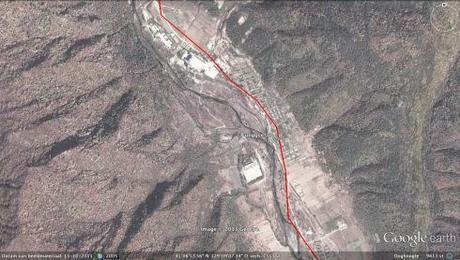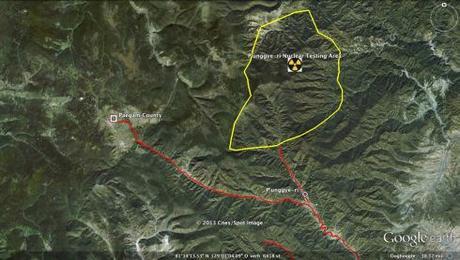
Overview of area around the nuclear test area near Punggye-ri, Kilchu County, North Hamgyo’ng Province. The red lines denote the closure or roads to human and vehicular traffic (Photo: Google image, route lines and annotations by M. Madden/NK Leadership Watch)
Yonhap News Agency,citing anonymous South Korean [ROK] government sources, reported on 12 February (Tuesday) that personnel and equipment may have been pulled out of the area close to the DPRK’s nuclear test site in P’unggye-ri, Kilchu County, North Hamgyo’ng Province. According to Yonhap ”no movement of manpower and equipment has been observed since Friday [8 February] at the country’s Punggye-ri nuclear test site.” An unnamed official said “When manpower and equipment are withdrawn, it can be an indication that a nuclear test is imminent. We’re watching the developments closely to know whether a nuclear test is imminent or it’s another deceptive tactic.” This follows another report in South Korean media that while the date of a nuclear test “still remains unclear, with the tension expected to enter the most critical phase this week, a senior official in Seoul said Monday [11 February]” and this week will be “the most critical point.”

The community of Punggye-ri, located 12.5 km (7.7 miles) from the nuclear test area (Photo: Google images)
Speculation among South Korean officials and experts about a forthcoming nuclear test occurred after an 8 February 2013 essay appeared in DPRK media outlet T’ongil Sinbo said that “the United States and hostile forces, based on their own hypothesis and arguments, jumped to the conclusion that the Republic would conduct a ‘third nuclear test,’ and they are prattling that if this were to become a reality, they should not only impose ‘high-intensity sanctions’ but even mount a ‘preemptive attack’” and “The United States and hostile forces’ reasoning behind “the nuclear threat of the North” is brigandish sophistry coercing unconditional submission and surrender, as it argues that the nuclear weapons possessed by the Republic constitute some kind of ‘threat,’ though they are for the purpose of defending the dignity and sovereignty of the nation and the peace and security of this land by boldly countering the United States’ threat of war of northward aggression and nuclear threat that are becoming more undisguised with each passing day. This does not work on the Republic, though its pawns may take it seriously.”
South Korean government officials described the T’ongil Sinbo essay as “a distraction tactic.” Other North Korea experts said that “that Pyongyang plans to check Washington and Beijing’s responses to its changed rhetoric in order to consider additional options” and quoted Professor Kim Yong-hyun of the North Korean Studies Department at Dongguk University who said “North Korea could show the international community its new uranium enrichment facility in order to boast its nuclear capabilities that have grown considerably.”
According to FNK, road closures and blockages were put in place on 5 February. Roads to and around P’unggye-ri were closed to vehicular and human traffic indefinitely and prevented DPRK citizens from traveling from North Hamgyo’ng Province to Paegam County, Ryanggang Province. Personnel from the Military Security Command wearing armbands “are guarding the roads, showing no sign of allowing passage no matter how one pleads one’s case.” FNK‘s source recalled security precautions prior to the October 2006 nuclear test saying the roads “were completely blocked from 7 to 20 October during the nuclear test conducted in October 2006. People who are stranded, unable to come and go, are worried about ‘how their families waiting at home would manage to live if movement of the populace is restricted for 15 days like the time of the last test’.” The FNK source also noted that “bribes that worked with soldiers and security officials enforcing control and restriction in the past proved to be ineffective this time, leaving one to only wait with nothing to be done.”

(Photo: Google image)
Filed under: 2013 Strategic Rhetoric, 2013 tactical rhetoric, 2nd Academy of Natural Science, Administration Department, Central Committee, Central Military Committee, Civil Defense Department, colonel general, critical infrastructure, DPRK Cabinet, DPRK External Relations, DPRK-United Nations Relations, General Affairs, gsd, gsob, Guard Command, internal security, Kim Family, Kim Jong-il, Kim Jong-un, KJI Personal Secretariat, Korean People's Army (KPA), Korean People's Internal Security Forces, Korean Workers' Party (KWP), KPA construction battalions, KPA construction brigades, KPA East Command Zone, KPA General Staff, KPA General Staff Nuclear Chemical Bureau, KPA supernumerary organizations, kpif, Kwangmyongsong-3, KWP Science and Education Department, Machine Building Industry Department, military security command [msc], Ministry of Extractive Industries, ministry of people's security, Ministry of State Security, Ministry of the People's Armed Forces (MPAF), National Academy of Defense Sciences, National Defense Commission (NDC), NDC Administration Department, NDC Policy Department, North Korean press, nuclear weapons, Organization and Guidance Department, Punggye-ri Nuclear Test Site, Second Economic Committee, Second Economy Commission, Secretariat, Six Party Talks, State Security Department, Third Floor, tunnel construction, Unha-3 Carrier Rocket, Young Red Guard
